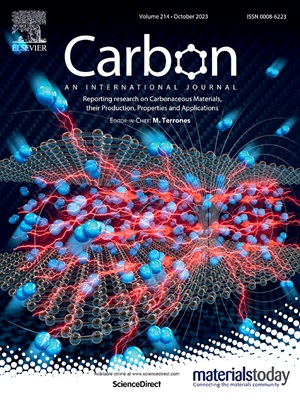Lightweight multifunctional carbon film current collector stabilizes lithium metal anode
IF 11.6
2区 材料科学
Q1 CHEMISTRY, PHYSICAL
引用次数: 0
Abstract
Lithium metal anode (LMA) is an ideal anode candidate for high energy density lithium batteries. However, metal lithium (Li) with high chemical activity and low redox potential not only leads to an unstable Li-electrolyte interface but also Li-current collector (CC) interface is susceptible to electrochemical corrosion, which has a serious influence on the overall stability of LMA. Herein, we report a polyaniline-derived carbon (PIC) thin film material that can be used as a novel LMA CC. PIC not only has the advantages of low density, good electrical conductivity, and high thermal conductivity, but also shows good compatibility in both ester and ether electrolyte systems. PIC beyond the support and conductive role of Cu foil, and the appropriate lithiation reaction with Li can form a passivation layer to effectively inhibit the electrochemical corrosion at the Li-CC interface. Thanks to the utilization of PIC CC, the reversibility and stability of Li||PIC half-cells are significantly improved, and the coulombic efficiency of the PIC-Li||NMC811 battery is significantly enhanced. In addition, PIC and thin Li (tLi) were tightly coupled by a simple process, the voltage polarization of PIC-tLi||tLi-PIC symmetric cells is noticeably reduced, and the corresponding PIC-Li||NMC811 pouch battery has a capacity retention rate of 92.2 % for 350 cycles. Remarkable, this study presents a novel cost-effective approach to using polyimide-derived carbon film as an LMA CC, resulting in stable and long-lasting LMBs.

轻型多功能碳膜集流器稳定锂金属阳极
锂金属负极(LMA)是高能量密度锂电池的理想负极。然而,化学活性高、氧化还原电位低的金属锂(Li)不仅导致Li-电解质界面不稳定,而且Li-电流收集器(CC)界面容易发生电化学腐蚀,严重影响LMA的整体稳定性。本文报道了一种新型聚苯胺衍生碳(PIC)薄膜材料,它不仅具有密度低、导电性好、导热性高的优点,而且在酯类和醚类电解质体系中都表现出良好的相容性。PIC超越了铜箔的支撑和导电作用,与Li适当的锂化反应可形成钝化层,有效抑制Li- cc界面处的电化学腐蚀。由于PIC CC的使用,Li||PIC半电池的可逆性和稳定性得到了显著提高,PIC-Li||NMC811电池的库仑效率得到了显著提高。此外,通过简单的工艺将PIC与薄锂(tLi)紧密耦合,PIC-tLi||tLi-PIC对称电池的电压极化明显降低,相应的PIC-Li||NMC811袋状电池的容量保持率为92.2%,可循环350次。值得注意的是,这项研究提出了一种新的经济有效的方法,使用聚酰亚胺衍生的碳膜作为LMA CC,产生稳定和持久的lmb。
本文章由计算机程序翻译,如有差异,请以英文原文为准。
求助全文
约1分钟内获得全文
求助全文
来源期刊

Carbon
工程技术-材料科学:综合
CiteScore
20.80
自引率
7.30%
发文量
0
审稿时长
23 days
期刊介绍:
The journal Carbon is an international multidisciplinary forum for communicating scientific advances in the field of carbon materials. It reports new findings related to the formation, structure, properties, behaviors, and technological applications of carbons. Carbons are a broad class of ordered or disordered solid phases composed primarily of elemental carbon, including but not limited to carbon black, carbon fibers and filaments, carbon nanotubes, diamond and diamond-like carbon, fullerenes, glassy carbon, graphite, graphene, graphene-oxide, porous carbons, pyrolytic carbon, and other sp2 and non-sp2 hybridized carbon systems. Carbon is the companion title to the open access journal Carbon Trends. Relevant application areas for carbon materials include biology and medicine, catalysis, electronic, optoelectronic, spintronic, high-frequency, and photonic devices, energy storage and conversion systems, environmental applications and water treatment, smart materials and systems, and structural and thermal applications.
 求助内容:
求助内容: 应助结果提醒方式:
应助结果提醒方式:


